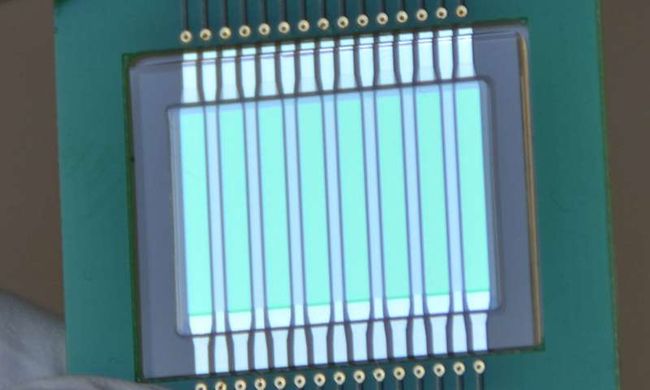
Dairy Quality Check from Fraunhofer Delivers Results in Minutes
In the project MOLOKO (Multiplex phOtonic sensor for pLasmonic-based Online detection of contaminants in milK), 12 partners from seven countries worked with the German research organization Fraunhofer to devise an expedited and inexpensive test for identifying quality factors in milk.
In a test lasting around five minutes, a new optoplasmonic sensor analyzed a milk sample for a total of six substances. The sensor demonstrated its use as an early warning system within the supply chain, detecting the substances before the milk was pumped into the tanker.
The sensor is equipped with receptors for specific antibodies that serve as indicators of various quality and safety parameters for milk, allowing dairy farms to carry out automated, on-site quantitative analyses.

Chip with integrated light source and light detector for analyzing contaminants in milk. Courtesy of Fraunhofer.
The entire system consists of a reusable microfluidic chip, organic light-emitting transistors (OLETs) or diodes (OLEDs), a sensor comprising organic photodetectors (OPDs), a nanostructured plasmonic grating, and the specific antibodies. The organic photodetector is undergoing development at the Fraunhofer Institute for Organic Electronics, Electron Beam, and Plasma Technology (FEP); and the microfluidic chip at the Fraunhofer Institute for Electronic Nano Systems (ENAS). The OLET is being developed by CNR-ISMN in Bologna, Italy, and the photonic grating by the company Plasmore srl in Pavia, Italy.
“The unique thing about our chip is that it can be reused,” said Andreas Morschhauser, a researcher at Fraunhofer ENAS. The target molecules in the milk are stripped from the immobilized antibodies by a regenerating buffer, allowing for the reuse of the antibodies. Fraunhofer has estimated the life of the chip to be 100 test cycles.
For each test, six parameters related to contaminants and proteins are measured. Morschhauser and his colleagues have developed a microfluidic system in the form of an automated, miniaturized, and replaceable cartridge. In addition to supplying information on milk safety and quality, the measured parameters also inform dairy farmers about the health and condition of each cow. This allows for early detection of infections so farmers can begin immediate treatment, which leads to more calculated antibiotic administration and conserving their use.
“Light emitted by the transistor falls onto a grating coated with antibodies specific to the various substances being tested for,” said Michael Törker, a researcher at Fraunhofer FEP. “When milk is flushed over the grating, any target molecules in the milk then bond with the antibodies. This alters the refractive index in the immediate vicinity of the grating, which in turn modifies how this light is reflected. The reflected light is registered by the photodetector, which measures minimal changes in the refractive index.” This is known as surface plasmon resonance and occurs on specially structured nanogratings, providing researchers and farmers with rapid and highly sensitive readings.
Fraunhofer says the goal will be to use the biosensor at various points along the value chain, both as a lab device and in dairy equipment. Researchers say the sensor will also be suitable for testing the quality of liquids other than milk, such as beer or water, just by modifying the immobilized capture molecules and the requisite reaction buffer.
Initial results from the development of the optoplasmonic chip will be shown at CES 2020 in Las Vegas Jan. 7-10, 2020.
/Buyers_Guide/Fraunhofer_FEP/c32119